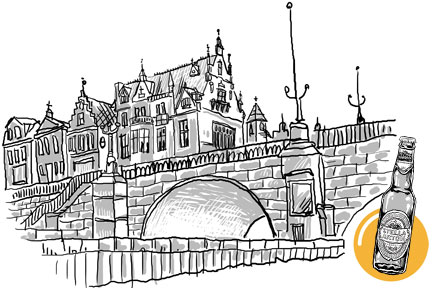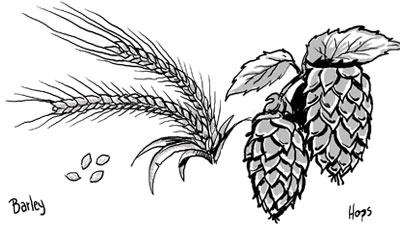We quizzed Josh Deth of Revolution Brewing—the much-buzzed-about Logan Square brewpub that’s aiming for a November launch—on the full story, from first glimmer to final recipe, of one of the spot’s four permanent beers: a sunny ale called Cross of Gold. Here, a look at its evolution through gold-colored glasses.

 |
1974
Josh Deth (right) is born in Miami but spends his first year in Leuven, Belgium, the home of Stella Artois. “Maybe it had some kind of profound impact on my life,” he says.
1992-96
While at the University of Michigan, Deth develops an interest in homebrewing and often visits the nearby Bell’s Brewery. In 1995 he scores a summer job at Chicago’s now-defunct Golden Prairie, the last brewery, pre-Revolution, to operate in Logan Square. “We were drinking 22s of Bell’s Solsun before it became Oberon. It cost a little extra, but we weren’t legal anyway,” Deth says.
1996-97
 |
After graduation, Deth works at Chicago’s Goose Island, where the beer lineup includes a blonde ale, and there he meets Jim Cibak, a fellow brewer.
A brief history of Jim Cibak: Siebel Institute (Chicago) >> Weinkeller Brewery (Berwyn) >> Goose Island (Chicago) >> Three Floyds Brewing Co. (Munster, Ind.) >> Firestone Walker Brewing Company (Paso Robles, Calif.) >> Crown Brewing (Crown Point, Ind.) >> Revolution Brewing
Blond ambition: “I’ve been thinking about a golden ale for a long time,” Deth says. “At Goose Island, Jim and I brewed a blonde ale, which is now offered seasonally. It was a great fruity ale that wasn’t too sweet or hoppy—that’s what our beer is modeled after. I started thinking of our beer as gold rather than blonde. There’s an association with the female sex with ‘blonde’ that works both ways: It can be appealing, but it’s not manly enough for some people.”
2000
Deth leaves Goose Island to pursue plans for his own brewery. With friends, he incorporates as Revolution Brewing but fails to secure a lease. He regroups and opens Handlebar in Wicker Park in 2003. “Working in a commercial brewery is what gave me the drive to do my own thing. You think, I could do this better. [I could] make it more unique,” he says.
2005
With Handlebar a success, Deth takes the helm at the Logan Square Chamber of Commerce. His duties include helping neighborhood businesses find locations—a perk. He keeps up his experiments in homebrewing, including variations on a blonde ale. “You can legally brew 200 gallons a year at home," he says. "Part of the deal with my wife was, if I opened the brewery, I had to get [my homebrewing system] out of the basement.”
2008-09
Deth closes on 2323 North Milwaukee Avenue, and construction begins on Revolution. He settles on four year-round beers: a Belgian white ale, a pale ale, a mild ale, and a golden ale.
5/09
Deth hires Cibak as his brewmaster. The two begin honing recipes, including the golden ale to be called Cross of Gold.
Going for gold: “A friend, Michael Burton, came up with the idea of naming a beer Cross of Gold [from William Jennings Bryan’s speech against the gold standard at the 1896 Democratic National Convention in Chicago]. It’s one of the best political speeches. It’s got a Chicago hook, and it’s got a common-man hook. Bryan was a populist, and in some ways, that’s what we’re doing as brewers, appealing to people’s populism. He was also a prohibitionist, but I think we can look beyond that.”

6/09
Deth and Cibak brew the first test batch of Cross of Gold in the basement of Deth’s Logan Square home. While pleased with the results, they want a slightly crisper flavor. “You can calculate everything on paper, but you need to taste the finished product to say ‘Let’s tone the bitterness down’ or ‘Let’s pull this malt back a bit,’" Cibak says. "You can’t hide any flaws in a light beer. It’s like a blank canvas.”
The recipe: “The main science of brewing hasn’t changed much in hundreds of years,” Deth says—which means the basic recipe for Cross of Gold is the same as for any beer: water, malt, hops, and yeast. “But with 50 different kinds of malt and 40 different kinds of hops, you get all of these [flavor] permutations.” COG calls for three kinds of malt—pale, wheat, and aromatic—and Cascade hops, with Centennial hops added later. As for the water: “Chicago has great water, some of the best in the U.S.,” Deth says. “Lake Michigan water.”
Come the revolution: “There’s this historic connection between beer and activism—at the very least, quenching the thirst of activists after a hard day’s work,” Deth says. “There were the lager beer riots in Chicago. And then there’s the craft-beer revolution. Twenty or 30 years ago, all the beer you could get was crap. Now there’s an amazing spectrum of flavors. [Plus,] there’s the green revolution, the sexual revolution. There will be a revolution in ten years we don’t know the name of yet, but if we’re still around, we’ll name a beer after it.”
7/09
Deth and Cibak brew a second basement batch. This time, they use a step mash—adding boiling water to the grain in two stages; they also increase the beer’s fermentation time and try different hops. “You only want to change a couple of things at a time so you can see what makes a difference," Cibak says. "That’s why you need really good notes: Once you hit on exactly what you want, you don’t want to be throwing stuff at the wall, trying to replicate it.”
8/09
After fermentation, the guys try the second batch but find it a touch too dry. They plan to raise the temperature in the next round for a slightly sweeter result. Meanwhile, Rev’s brewing equipment is installed.
10/09
Projected first brewing of Cross of Gold in the brewpub. Although Cibak is a stickler for keeping precise notes, brewing on a much larger scale with different equipment can lead to subtle variations in flavor. “If you make a stinker, you make a stinker; then you make something else," Deth says. "But we should have time to really test our system out.”

11/09
Targeted opening of Revolution Brewing and first pouring of Cross of Gold, at $5 a pint (above, the tap handle).
The brewing process:
1. Water is poured into a large pot, called a hot liquor tank, where it’s heated before being transferred to another tank, or mashtun, where the malt is added.
2. This concoction is strained, or sparged, producing sugar water that is then boiled.
3. Hops are dropped in early in the boiling process to tone down the sweetness, then again later to add flavor.
4. The boiled sugar water, known as wort, is moved to a fermentation tank, where the yeast is added. Over several days, the yeast gobbles up much of the sugar, producing carbon dioxide and alcohol. Houston, we have a beer. Prost!
Illustrations: John Kenzie


